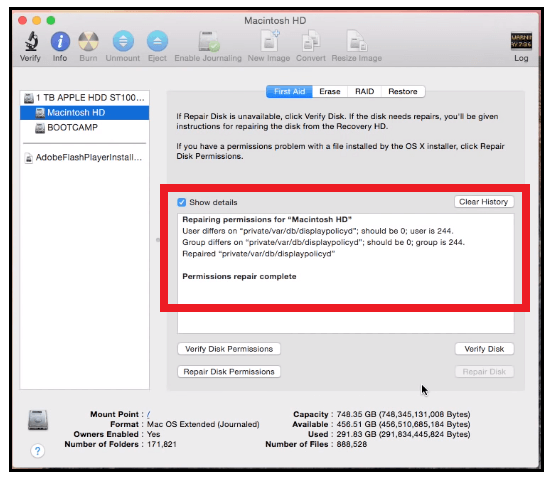How to defrag a computer?
How to defrag a computer

Topics Covered
- What is Defragmentation?
- What is the need of defragmentation?
- Advantages of Defragmentation
- When to defrag your computer
- Defragmentation for your SSD
- Defrag your computer running on windows 10
- Defrag your computer running on windows 8
- Defrag your computer running on MAC
What is defragmentation?
Defragmentation is likely known as a solution to a hard drive that’s running out of space. It boosts the performance and increase the loading speed for your files and folders that had degraded. The reason that disk defragmentation is a thing is because of the process following which a mechanical hard drives stores data. Defragmentation reduces the number of fragmented files on a hard drive. It reorganizes related data files and puts them in the same physical location on your hard drive. For example, you installed data on your hard drive, such as programs, documents, music, video, etc. That data is divided into multiple chunks of data stored on the hard drive, so after a while, your hard drive data is spread out in mixed in with other data files. So, when you do a defrag the computer, it will reassemble all of the related chunks of data that had been broken up, and it'll put them together in the same physical location. It puts all the files that belong to a specific program together, all the files that belong to a specific video together, the same with document music, and so on. It also puts all the free space on the hard drive together, and after the defragmentation is complete, the files on your hard drive where all the related files are together and everything is beautiful and organized. It means that when you want to run one of the programs, the computer will run quicker because the hard drive doesn't have to do extra work by fetching data from different areas of the hard drive. As data is added and deleted, the free space on the hard drive will get smaller and will tend to spread out in different locations on the hard drive instead of in one general location.
What is the need of defragmentation?
Think of a hard drive as a long sheet of paper when you first install your operating system and put things on it everything is stored in basically a straight line starting at the top and working your way down. Over time you will start changing or deleting files and adding new ones, so suppose one of the files you delete is located in the middle of the sheet, and once you deleted, it will create a free space that right’s in the middle of a bunch of other data. The next question that arises is what happens to the disk free space.
Your computer management system is smart enough, and it will not let any space wasted. Suppose you have stored another large file, unlike a video on a hard drive inside a specific folder. But as expected, the computer will not store the entire video sequentially. It will place some part of that large video file in that free space until it’s filled up and then place the remaining of the file elsewhere in your hard drive (also called file fragmentation). File fragmentation slows down the speed of your computer and drastically affects its performance. It is because, in any mechanical drive, the platters have to physically spin to allow the driver's head to access the files. If a file is scattered or broken up into several parts stored at different locations over your desk, your disk it’s naturally doing to take a longer time to search, compile, and bring up the desired file.
The free space of your hard drive is spread out into different chunks so if another program is installed the computer may not be able to find enough free space in one location on the hard drive to accommodate the program because the free space is scattered in different locations. For example: if we install another program on this hard drive and if the computer can't find enough free space in one area for this program, the computer was shattered the program's data files in smaller chunks.
Advantages of Defragmentation
Defragmentation reverses these effects by doing two things:
- Reassembles broken files: It reassembles any file that has been broken into little pieces and places it in one physical location on your disk, resulting in faster access.
- Rearranges free space into one block: It rearranges most of the free space on your drive into one sizeable continuous chunk. Thus, your PC won’t try to fragment new files or information and divvy them up into little cubby holes of free space. It also does its best to put the free space together in one big chunk, and after the defrag is complete, the computer will run faster and more efficiently. All the related data files are together, and all the free space is put together, so you only have to do a defrag on mechanical hard drives because mechanical hard drives have disks that spin so that the heads can read and write data files.
When to defragment your Computer?
When you have related files scattered into different locations on the hard drive, this is known as File Fragmentation. When you have a fragmented hard drive, the computer will run slowly because the computer has to work harder to read and write data. After all, it is scattered all over the hard drive. When this happens, you need to do defragmentation to gather all of the related files that are scattered on the hard drive and put them together so that they are in the same physical location on the hard drive. Although there is no direct notification, but every computer gives a few signs that will indicate the user that it’s time to defrag the PC. The most frequent ones are as follows:
- If your files are taking more time to get load than usual.
- If your games are taking to start or load on your Windows environments.
- PC is working slow.
- Hearing your hard drive persistently buzzing into action
Defragmentation for your SSD?
Defragmentation does not end up with the identical performance aids for SSDs. The reason for this is that since SSDs don’t have any moving parts and the PC can access all the data at roughly the same speed regardless of which chip of the SSD is holding a particular file. Trying to defragment an SSD can do more harm than good. The cells that contain data on an SSD can only be written to so many times until they wear out and become completely useless. The cells on SSDs have to be erased before new data can be written to them; you can seriously lose performance over time.
Defrag your computer running on Windows 10
Following are the steps to defrag a computer running on Windows 10:
METHOD 1: DEFRAGMENT AND OPTIMIZE DRIVE
- Click on the windows start button and then in the search bar type defrag. The match will show you the option, “Defragment and Optimize Drives.” Scroll up and click on defragment and optimize drive desktop app.
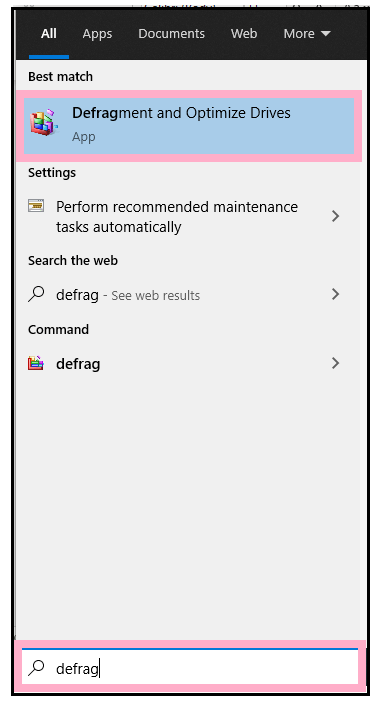
- That opens the optimize drive window, and you will notice that by default, the C Drive is selected.
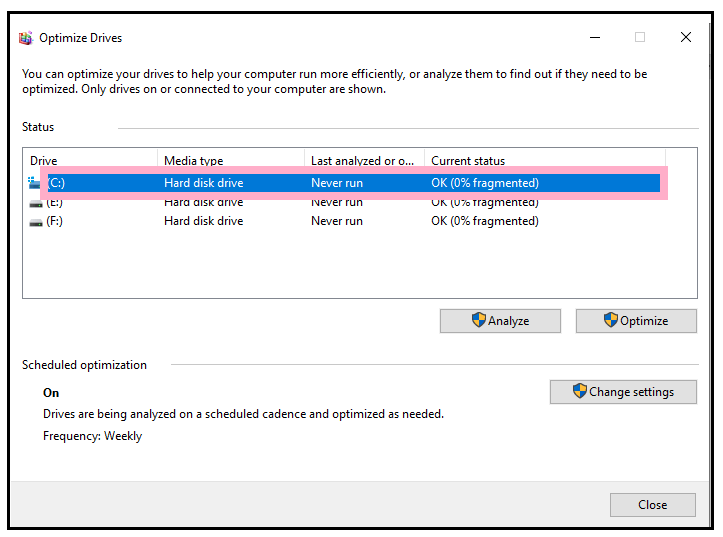
- At the bottom, there are analyze and optimize options are present to start the defragmentation process manually. Click on optimize button.
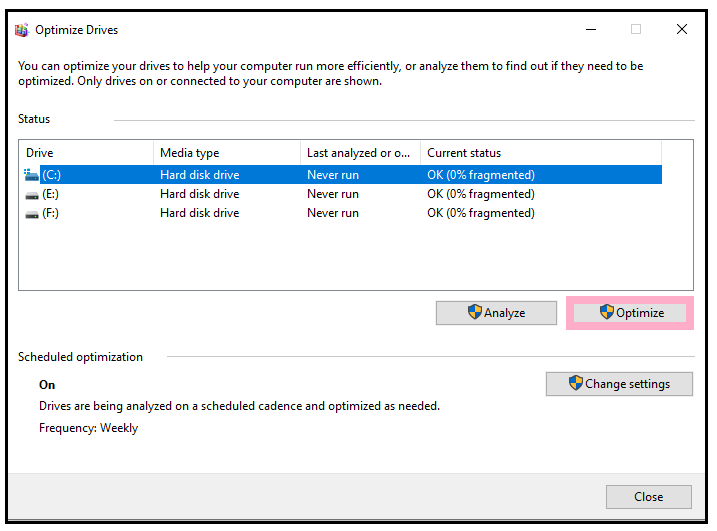
NOTE: WINDOWS 10 has the defragmentation automatically by default, and if you want to do it manually.
- When you click on optimize, it will analyze, optimize, and defrag at the same time. You will notice in the Last Analyzed bar it would show the status as running and in the Current status tab the analyze percentage will be displayed. It will go through 7 passes and complete itself within a minute. (could take a few minutes to a good number of hours if you have a larger drive or your computer it is not fragmented that badly).
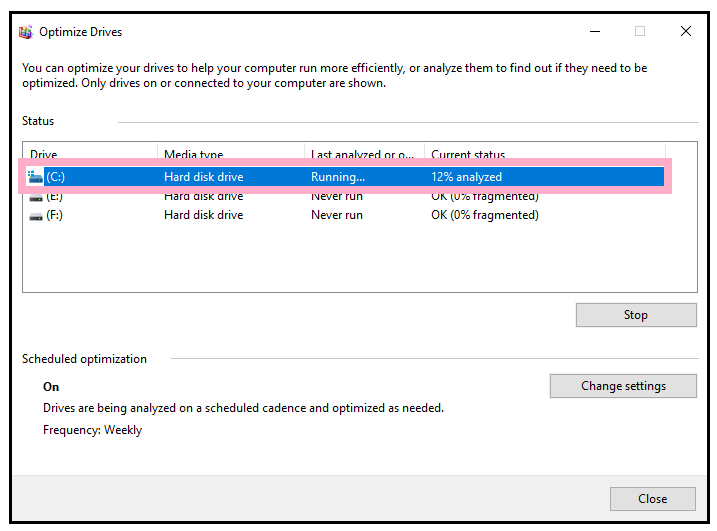
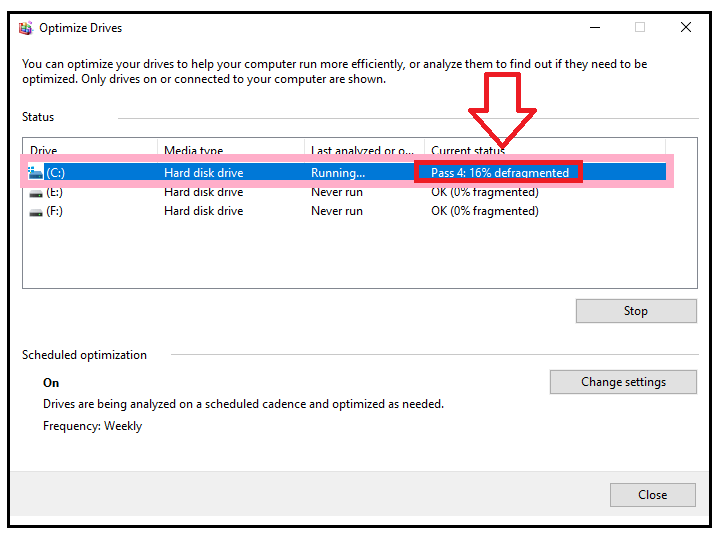
- Once it passes all the 7 stages, a message pops, stating its 0% fragmented. Hence, your disk defragmentation procedure is completed.
- Now, if you want to change the frequency of windows 10 automatically defragmenting your drive, click on Settings, and then from the frequency dropbox, you change it to weekly, monthly, daily, depending on your need.
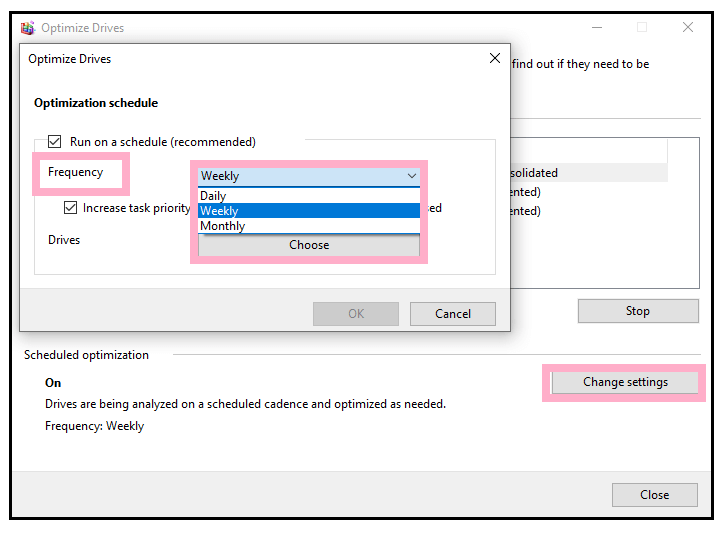
- You can also change the drive that you want to have automatically defragged. Click on the choose button. New window will be thrown which will display all the drives. Select the drives and click on OK button.
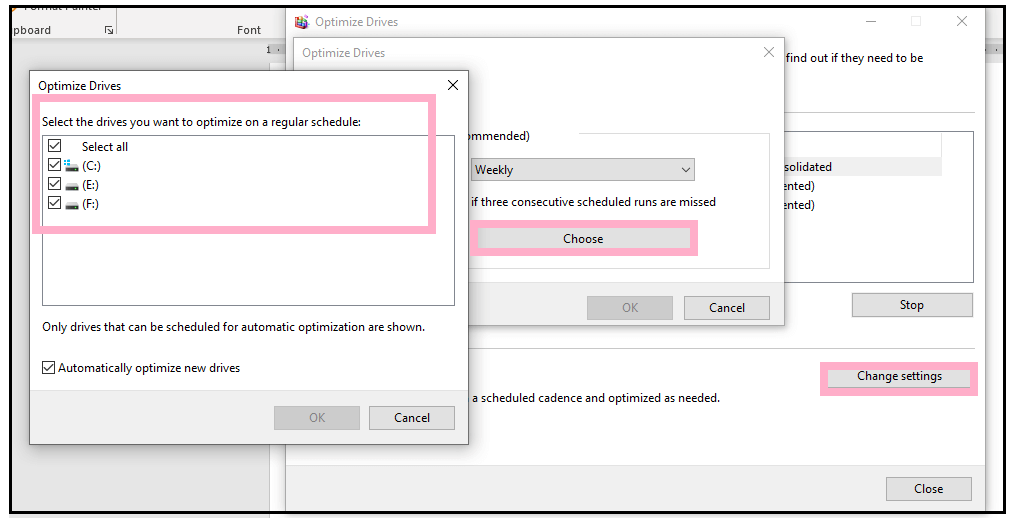
METHOD 2: FILE EXPLORER
- Click on the windows start button and then File Explorer. You can also use the window shortcut i.e., Windows button + E.
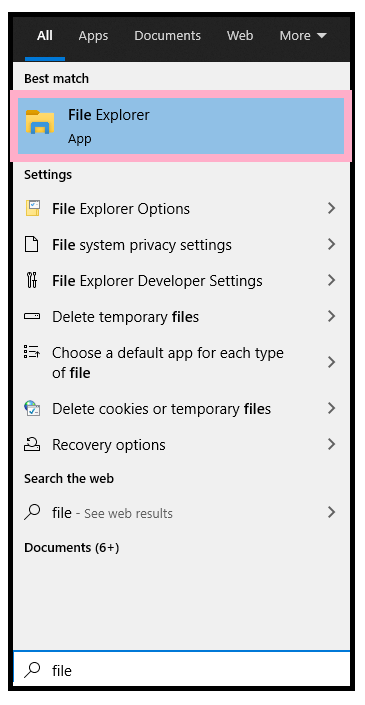
- On the left side of the pane, click on This PC icon.
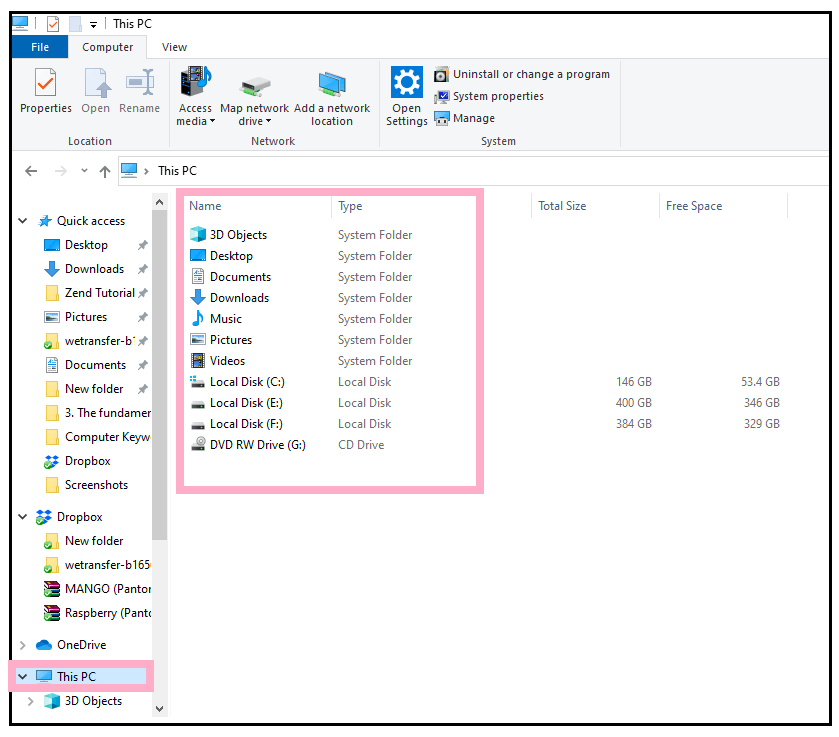
- All the drives will appear on the This PC window. Choose the drive which you want to defragment. You will notice on the top of the window, and several options will be displayed. Click on the Drive tools.
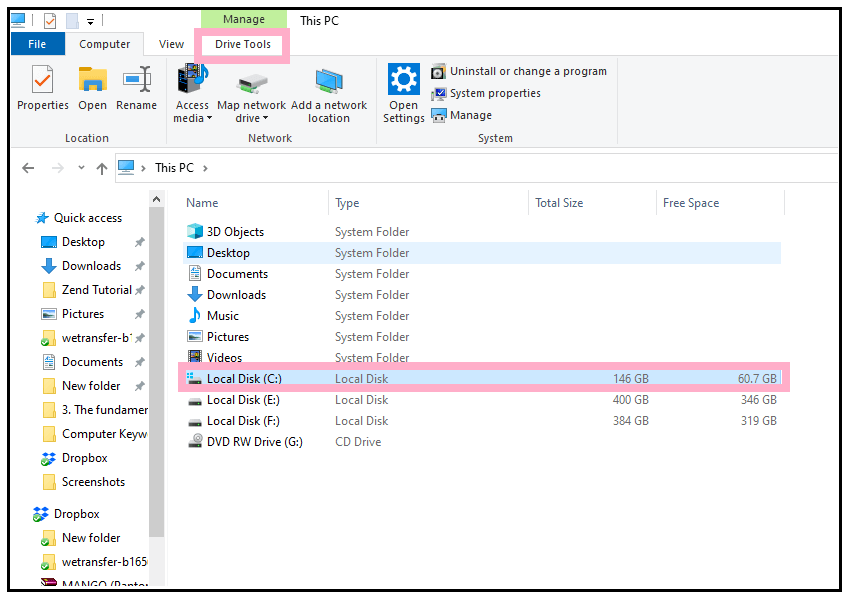
- Next, select the optimize button from the manage group.
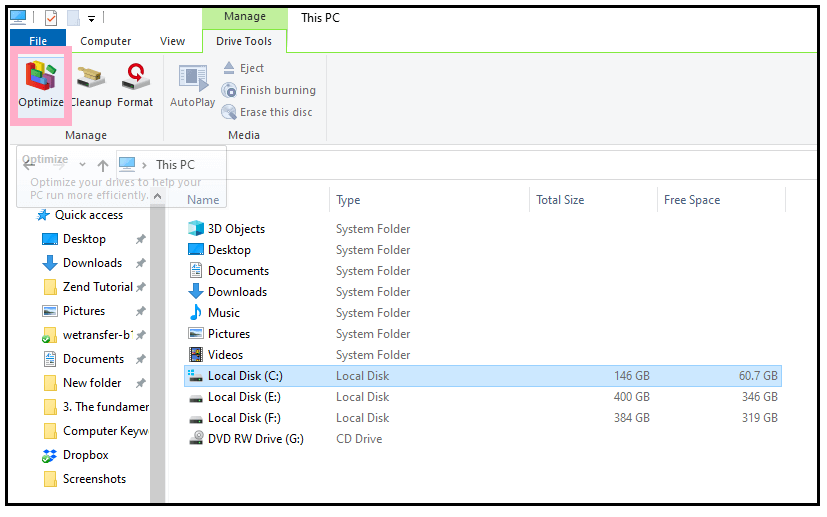
- The optimized drive window will appear. Click on the optimize button. Wait until the Windows completes the analysis and displays the percentage of the fragmented files in the selected drive.
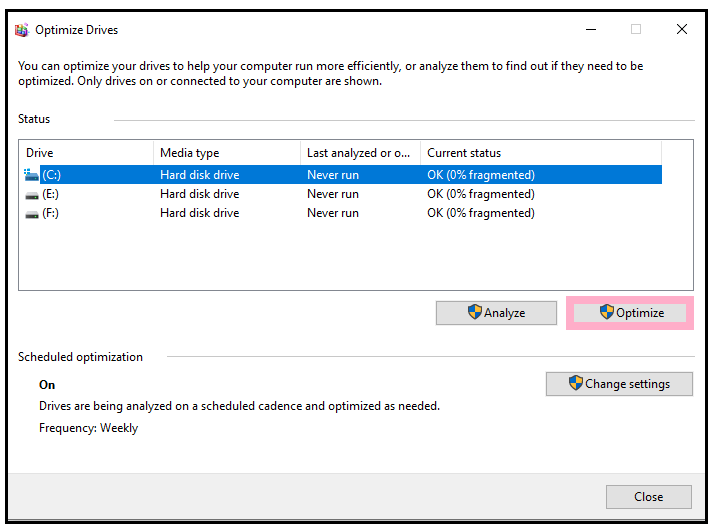
- After windows complete the analysis, click the optimize button to start the defragmentation process. It will sometimes take to complete the defragmentation wait until windows defragment the drive successfully.
- Once the defrag process is finished, you can also set schedule optimization. Click the change settings button.
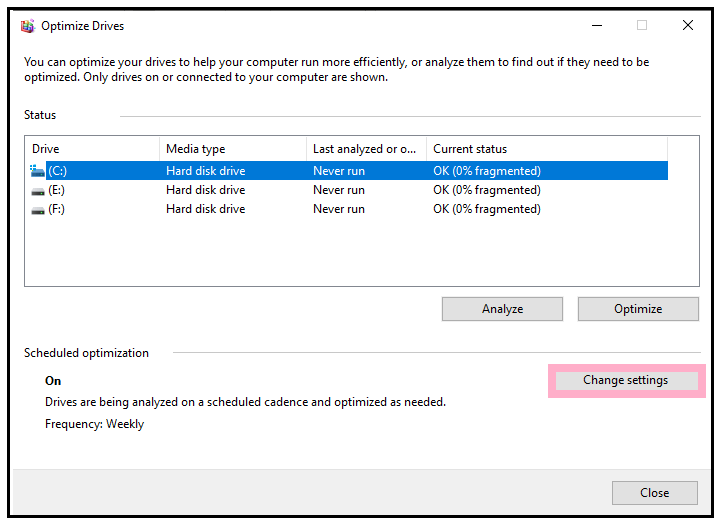
- From the frequency, drop-down select a daily, weekly, or monthly frequency you want. You can also select the drives you want to optimize on the regular schedule.
Defrag your computer running on Windows 8
Follow the given steps to defrag your computer running on Windows 8:
- Move your cursor to the right corner of your windows and open the charms menu. Scroll down and click on the search option.
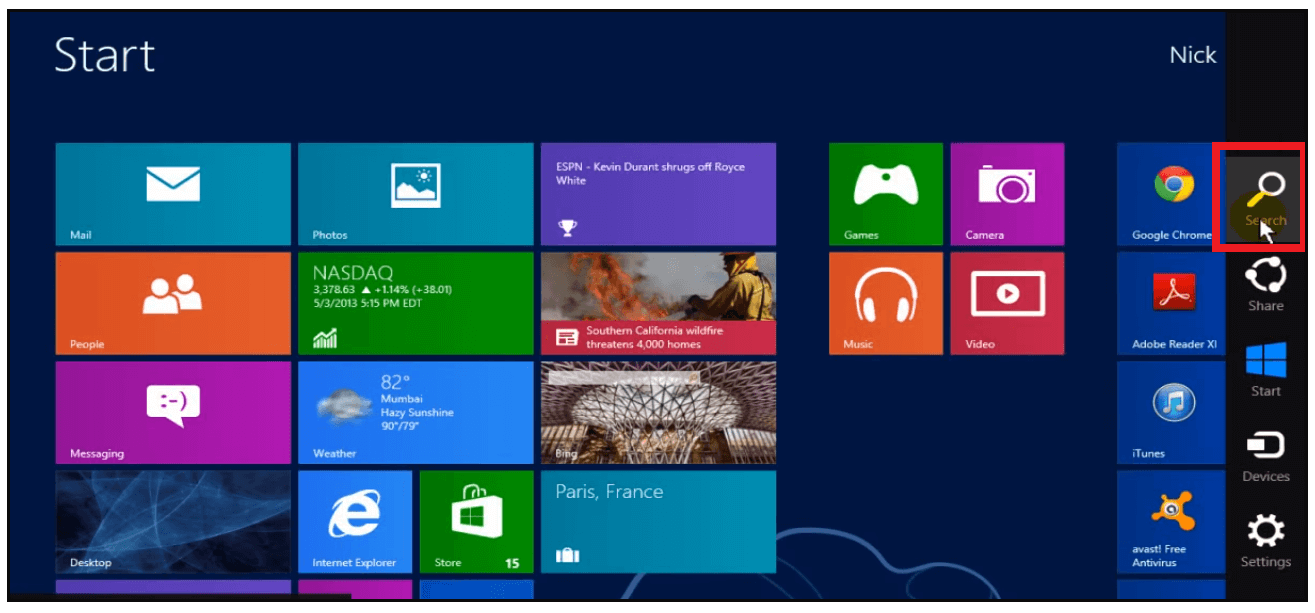
- All the apps will be listed in the window. Click on settings and the command search line type defrag. You will notice on the left side of the window screen it will match while showing few options. Go ahead and click on ‘Defragment and optimize your drive.’
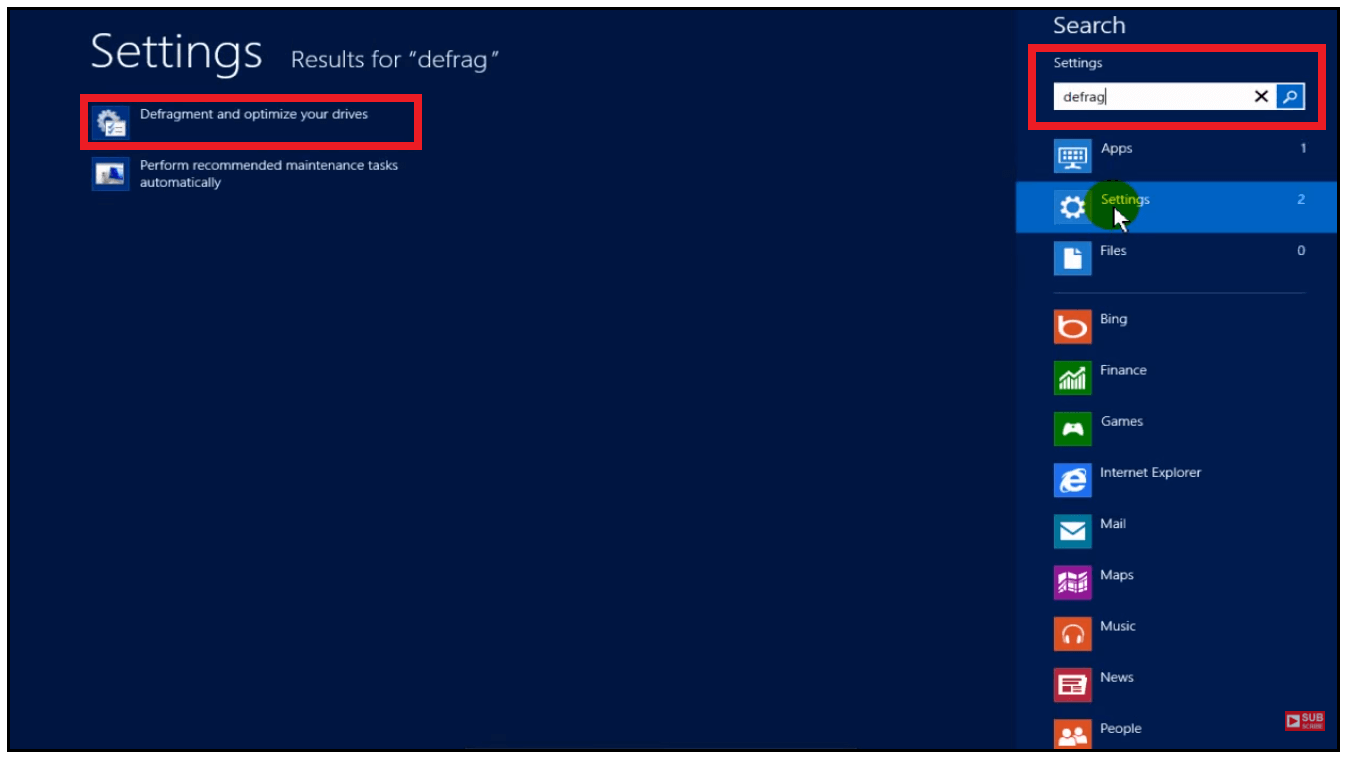
- The optimized drive window will pop up on your desktop. Go ahead and select the drive that you want to defrag. After that, click on the analyze button.
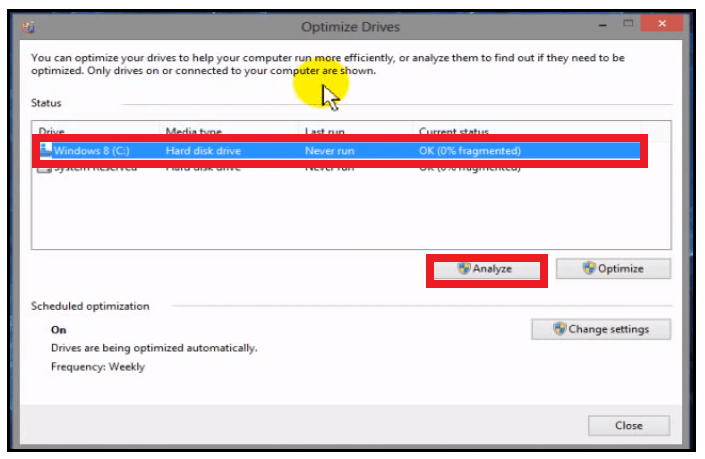
- Windows 8 will search out and will determine if the disk needs to be defragged or not. If it does, click on the optimize button.
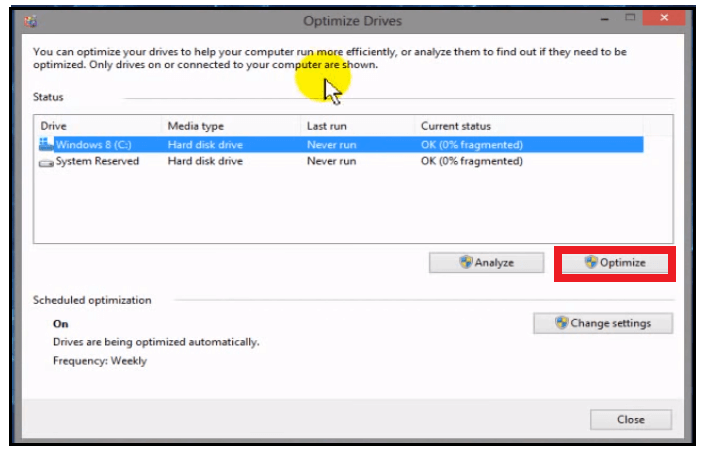
- This could take some time, so be patient and hand in there because it will eventually improve the speed of your computer once the defragment is completed.
Defrag your computer running on MAC
Follow the given steps to defrag your computer running on MAC:
- Click on your launchpad and from options click on Disk Utility.
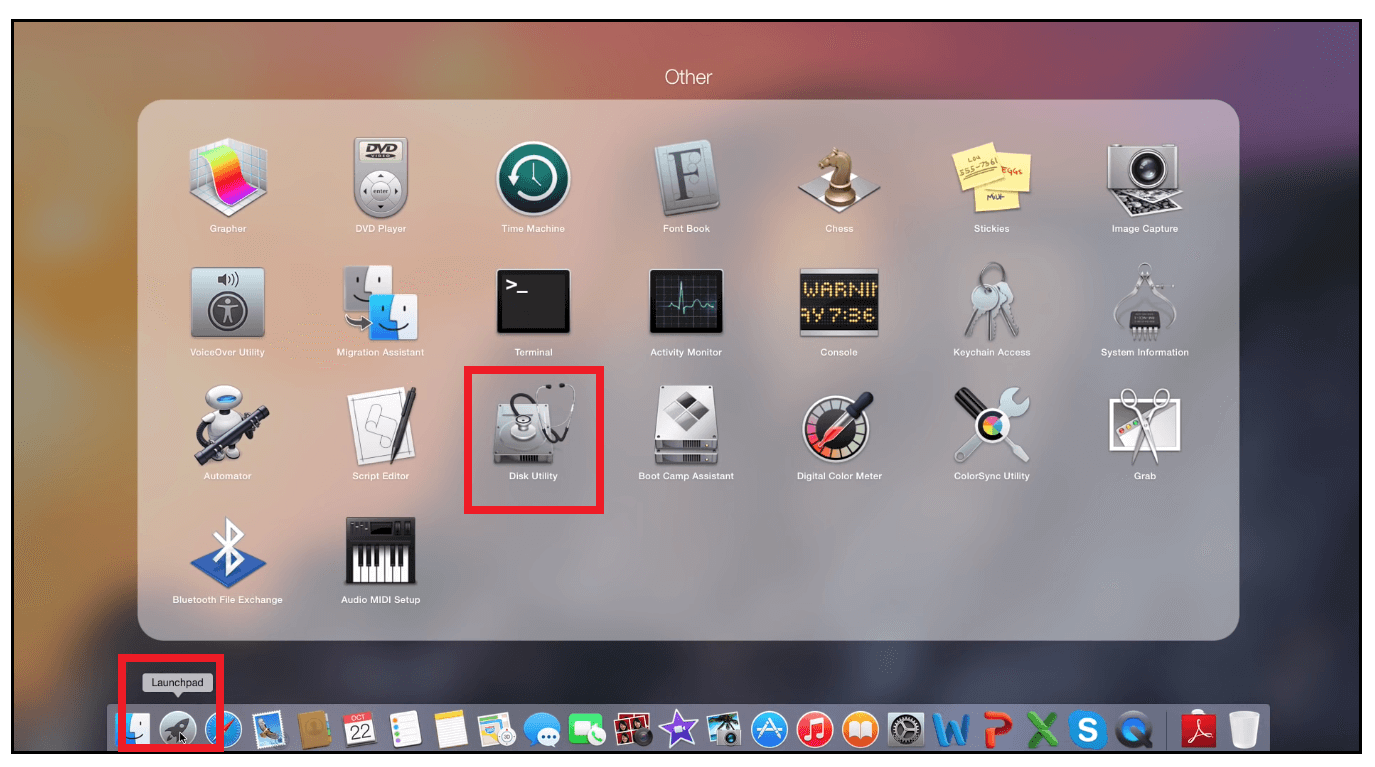
- You can also directly go to the utility folder of your launchpad. In the folder, click on the Disk Utility option.
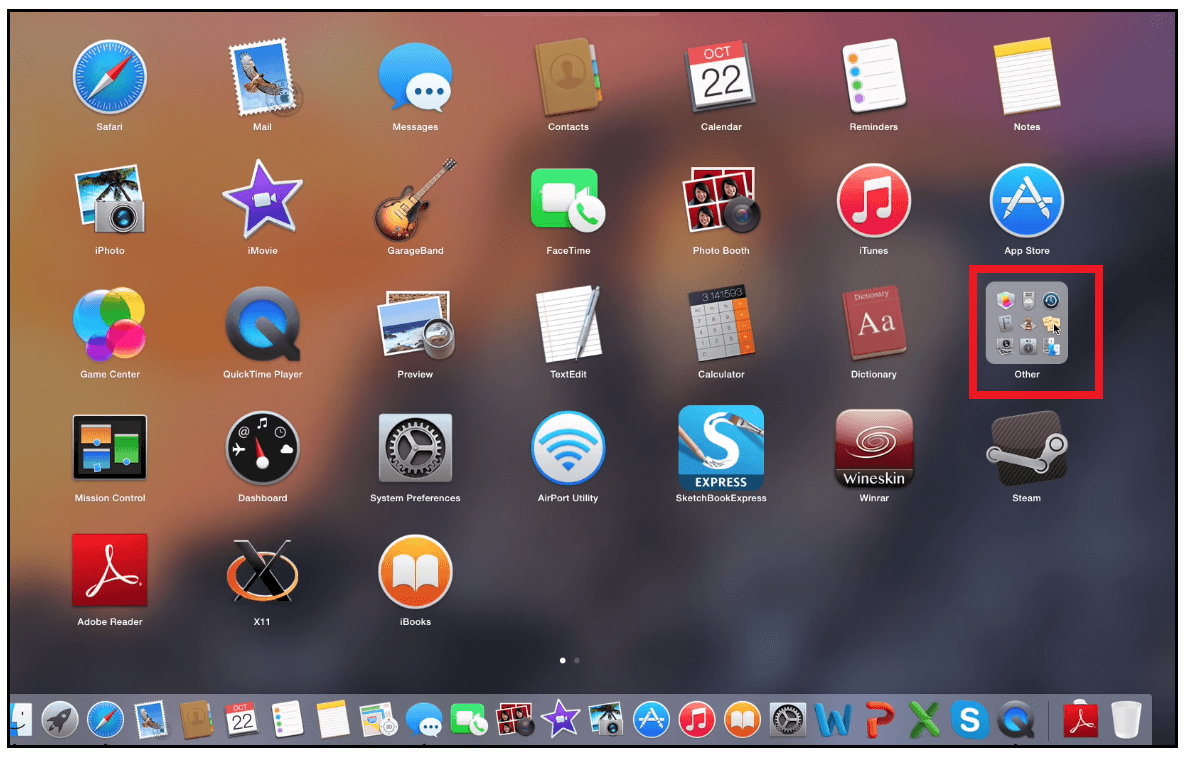
- The disk utility window will be displayed on your desktop. Click on your hard drive.
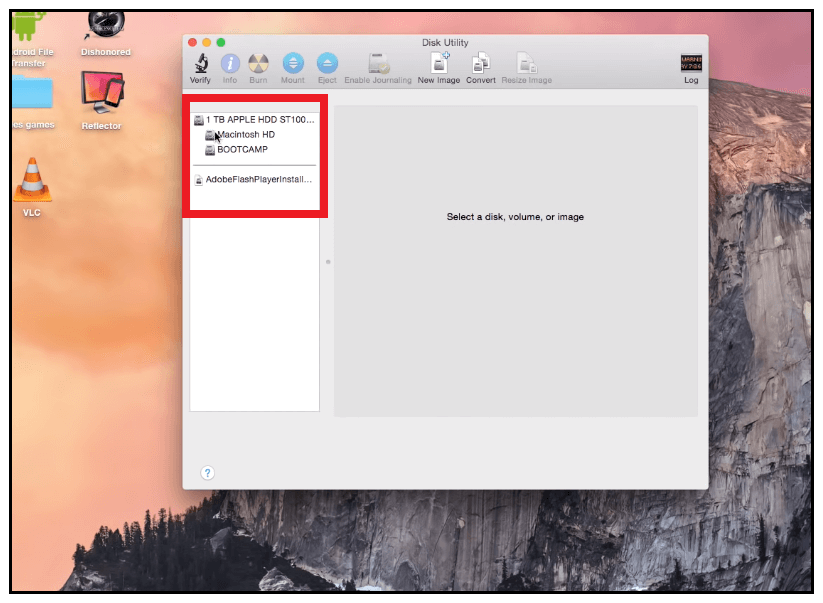
- On the right-hand side of the Disk Utility window, you will find four tabs named as First Aid, Erase, RAID, Restore. Click on First. All the details and the problems related to your hard disk will be shown in the ‘Show details’ box.
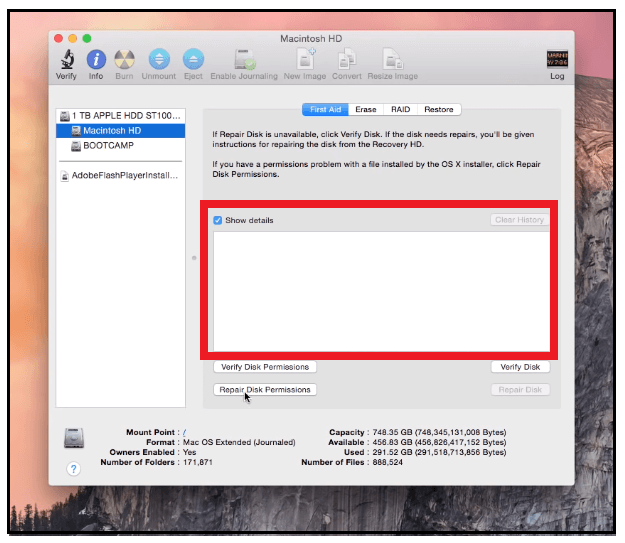
- Click on repair disk permission. This option helps you to fragment your disk.
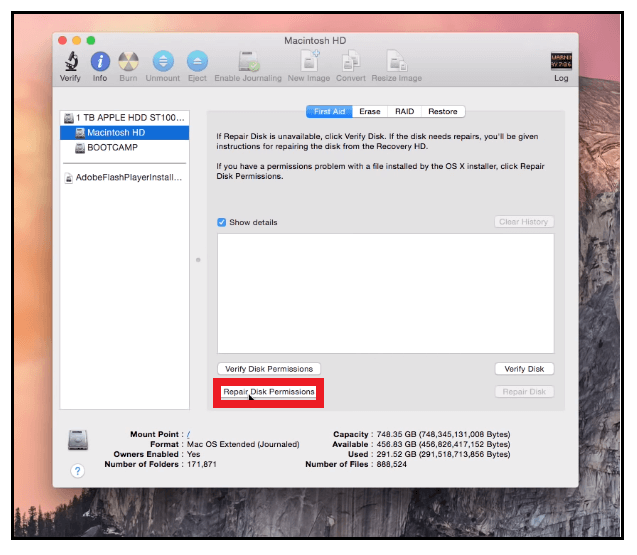
- At the bottom of the screen, you can view the estimated time. It could take from to a minute to an hour, depending upon your disk fragmentation. It will also show various other details regarding the disk, unlike capacity, available space, used space, and the number of processed files.
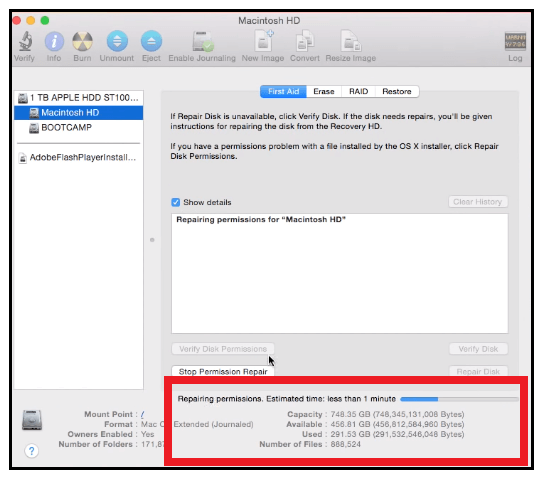
- Once it’s done on the details window you will get the notification stating,” permissions repair completed.” Your computer will become more speedy after the defragmentation process.
